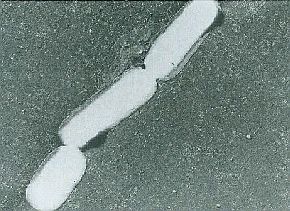Tokyo Food Safety Information Center » Good things to know » The microorganisms which cause food poisoning » Clostridium perfringens
Clostridium perfringens
Characteristics

Found in the digestive tracts of people and animals as well as widely throughout nature including soil and water, Clostridium perfringens is an anaerobic bacteria like Clostridium botulinum which does not like oxygen.
Clostridium perfringens can be detected even in the stool of healthy people. The carrier rate varies depending on diet and life environment as well as age, but in general elderly adults are found to be carriers more than young people.
Clostridium perfringens is also found in fish and the feces of livestock such as cattle, pigs, and chickens. Contamination in food is particularly common with meat (beef, pork, chicken, etc.).
As Clostridium perfringens produces highly heat-resistant spores, it can survive even high heating. Accordingly, when cooking large amounts of food, for example in a single pot, even when other bacteria die, the heat-resistant spores of Clostridium perfringens will remain.
The interior of food also tends to be an oxygen-free environment, making perfect conditions for Clostridium perfringens. As such, once food temperature falls down to reproductive temperatures, Clostridium perfringens spores germinate and the bacteria begins to multiply rapidly. Clostridium perfringens then passes through the stomach together with food and multiplies in the small intestine. When the bacteria transitions into spores, it produces toxic enterotoxin which causes symptoms such as diarrhea.
Due to outbreaks at school lunch facilities where large amounts of food are prepared in batches, Clostridium perfringens is also known as the “school lunch disease” and is accordingly characterized by cases of mass food poisoning affecting large numbers of victims.
Which foods can cause Clostridium perfringens infection?
Stews made with meats, seafood, and vegetables are frequent causes.
Like other sources of food poisoning, numerous cases of Clostridium perfringens have occurred at facilities which provide meals en masse such as restaurants, caterers, traditional Japanese inns, and schools. Cases of Clostridium perfringens are frequently caused by large meals prepared the day prior to consumption such as curry, stews, and soups which are allowed to cool in large cooking vessels at room temperature.
The belief that cooked food is safe is a source of Clostridium perfringens food poisoning outbreaks. Conversely, Clostridium perfringens is characterized by relatively rare occurrences in private homes in comparison with other sources of food poisoning.
What are the symptoms of Clostridium perfringens infection?
The incubation period for Clostridium perfringens is approximately 6 to 18 hours (with the average being 10). Symptoms include mainly stomach pain, diarrhea, and particularly abdominal bloating, with symptoms being on the light side.
What are the key points to preventing Clostridium perfringens infection?
- Avoid preparing meals the day prior to their consumption and eat cooked foods as quickly as possible after they have been made.
- When cooking large amounts of food together in one batch, take care to ensure that food is not kept for long periods of time at temperatures under which Clostridium perfringens reproduces easily.
- When forced to store large quantities of food prepared in a single batch, divide the food into smaller portions and refrigerate them as soon as possible.